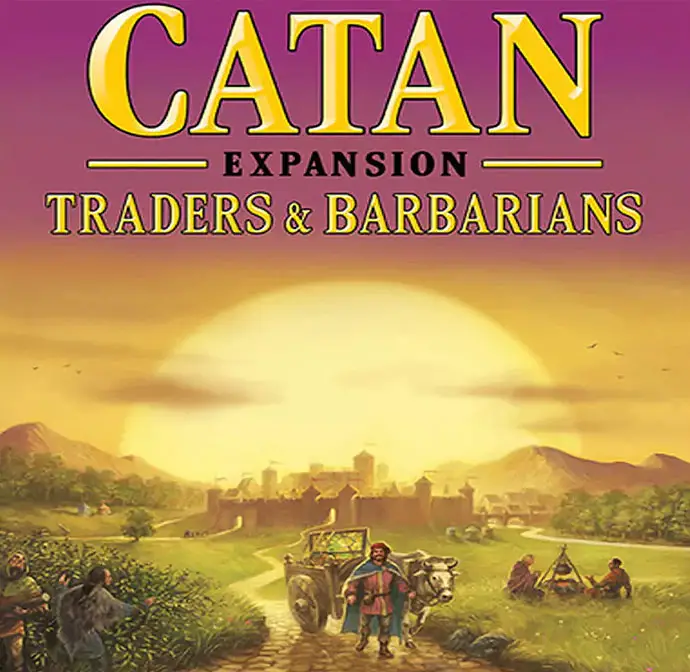
Components
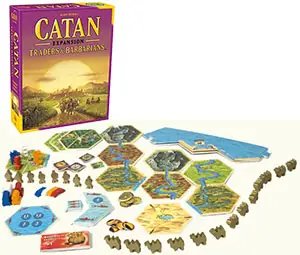
- 98 game pieces
- 120 cards
- 17 terrain tiles, fishing ground tiles, and sea frame pieces
- 40 gold coin counters (25 small, 15 large)
- 3 Special Cards/Tiles
- 21 Catan chits
- 36 commodity tokens
- 30 fish tokens
- 1 variants & scenarios rules booklet
The Game

The barbarians have been driven off, and peace is returning. The destruction the barbarians left in their wake is being repaired as fast as possible.
The castle where the Council of Catan holds session suffered particularly severe damage, but the restoration efforts are making real progress.
Now, the craftsmen need to finish the stained glass windows and the new marble statues. Marble must be transported from the quarry, sand must be brought to the glassworks, glass must be delivered to the Castle, and tools are needed as well.
The roads of Catan are bustling with traffic. Of course you are involved; the Council pays for transport in solid gold. Only some scattered barbarians are getting in the way-they're waiting. For you!
The Castle is being restored, so it will shine in new splendor. For this purpose, glass panes for the leaded windows are needed, along with marble for statues and interior decoration.
There are three new terrain hexes that serve as "trade hexes" for the transport of commodities.
Object of the Game
The players have the task of transporting glass and marble to the castle hex as well as providing the glassworks with sand and the marble quarry with tools.
Each transported commodity is rewarded with gold and counts as a victory point. The first player to reach a total of 13 victory points during his turn wins the game.
Setup
First, assemble the frame. Replace 2 frame pieces from basic Settlers (labeled 1-2 and 5-6) with the corresponding frame pieces provided in this expansion.
Then place the 3 trade hexes as shown in the illustration below. The sea side of each trade hex must match up with a sea side of the frame. Do not use the following 3 hexes from the basic Settlers game: the desert hex, 1 pasture hex, and 1 fields hex. Remove those 3 hexes from play.
Do not place number tokens on the 3 trade hexes-remove the "2" and the "12" number tokens from play. Place the remaining number tokens as specified in the set-up of the basic Settlers game, leaving out token "2" (B) and token "12" (H). When placing the number tokens, skip the trade hexes.
Arrange the commodity tokens into 3 stacks sorted by the pictures on their backs (castle, quarry, glassworks). Shuffle each stack and place it with the backs facing up (showing the building picture) beside the corresponding trade hex.


You receive the set of 5 Baggage Train Cards whose frame colors match your color. Stack the cards face down, sorted so that that the backs of the cards are in sequence from 1 to 5. Turn the top (1) Baggage Train Card of your stack face up and place it next to the stack - this is your active Baggage Train Card.
Place the 3 barbarians on the paths marked with black crosses. Use the new 25 Development Cards that this expansion provides for this scenario. Do not use any of the basic Settlers game Development Cards.
You receive 5 gold. Do not use the Special Card "Longest Road". Do not use the robber.
You set up as outlined in the basic Settlers game, except that your second settlement is replaced by a city. You still only receive 1 resource for each terrain hex adjacent to your city. Once you have built your city, place your wagon next to it - your wagon is on your city's intersection.
Game Rules
The normal rules for The Settlers of Catan apply. The changes are described below.
Trade Hexes
Each of the 3 trade hexes has a "central plaza" intersection - with a building. Four "interior" paths lead to this central plaza. For each trade hex, the following rules apply:
You may build roads on interior paths, according to the usual rules.
You may not build a settlement on the central plaza intersection of a trade hex (A).
You may not build roads on the three paths of a trade hex (B) that border on the sea.
You may build settlements/cities on the 4 land corners (intersections) of a trade hex; obeying the distance rule.
Example: The blue player and the red player have built roads on three out of four paths of the trade hex. No settlement may be built on the central intersection (A), and no road may be built on the 3 paths (B) of the trade hex's coast.
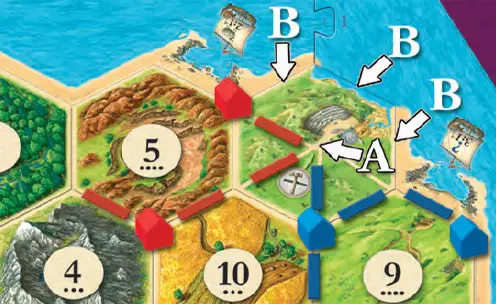
Movement
After you finish trading and building during your turn, you may move your wagon. The following rules apply:
I. Moving your wagon
You move your wagon along paths from intersection to adjacent intersection. Moving your wagon along a path from one intersection to an adjacent intersection costs 1 or more "movement points" (MPs).
Any number of wagons may occupy a given intersection.
At the beginning of the game, your wagon has 4 movement points to use each time you take your turn. You can increase its MPs by upgrading your baggage train.
When you move your wagon along a path, the movement point (MP) cost varies based upon whether or not the path is occupied by a road and/or a barbarian:
- The MP cost is 2 if the path does not have a road.
- The MP cost is 1 if the path has one of your own roads.
- The MP cost is 1 if the path has another player's road, but you must also pay 1 gold to that player.
- The MP cost is increased by an additional +2 if there is a barbarian on the path.
Example: The red wagon has 4 movement points. It can move (A) to the castle using 4 red roads (4 Mps). Or, it can move (B) to the castle using a roadless path (2 MPs) and 2 blue roads (2 Mps), but would owe blue 2 coins. Or, the red wagon can move (C) to the red settlement using 2 red roads (2 MPs) with a barbarian (+2 MPs).
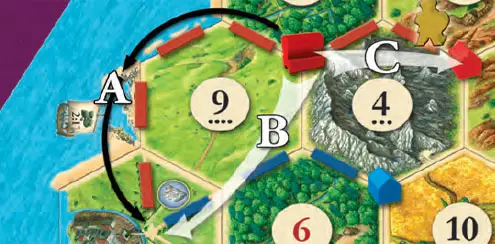
On your turn, you may pay 1 (and only 1) grain to increase your wagon's movement points by +2 for the current turn. You may do so even after already having used some or all of its MPs in the regular fashion.
Your wagon may stop and end its movement on any intersection it moves to. Unused movement points are lost.
Your wagon must stop and end its movement whenever it moves onto the central plaza of a trade hex.
If you do not have enough unused MPs to move along a path, you may not partially move along the path-your wagon must end its movement on an intersection.
II. Choosing an initial destination trade hex
When you first move your wagon, you should choose one of the 3 trade hexes to move towards (your wagon's initial destination). You may change your initial destination at will.
When your wagon eventually reaches the central plaza of this trade hex, you don't receive any gold-you don't have a commodity token to deliver.
However, you do receive the top commodity token from the stack corresponding to the trade hex. Turn it face up in front of yourself to reveal the commodity depicted on the front of the token. There are 4 different commodities:
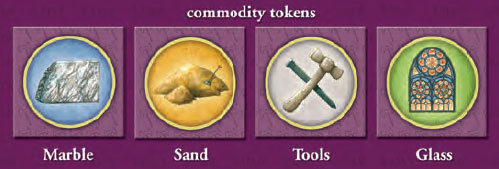
Each trade hex produces two different types of commodities.
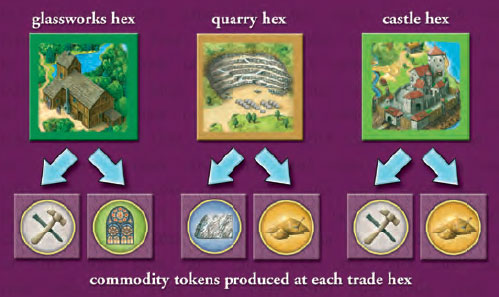
On later turns, you must move your wagon to the trade hex where this commodity can be delivered. You want to deliver glass and marble to the castle hex, tools to the quarry hex, and sand to the glassworks hex.
For example, if your wagon is on the glassworks hex and you have received a glass commodity token, you must move your wagon to the castle trade hex. A player may carry out only one delivery at a time. Only after completing a delivery, may you draw another commodity token.
III. Delivering Your Commodity
When your wagon stops at the central plaza of the trade hex corresponding to your commodity token, you must deliver that commodity:
- Turn the commodity token face down (showing the picture with a building). The token is worth 1 victory point.
- Depending on your baggage train (see below), you also receive between 1 and 5 gold.
- Take and reveal another commodity token as outlined above-this commodity token determines your new destination trade hex.
IV. Upgrading Your Baggage Train
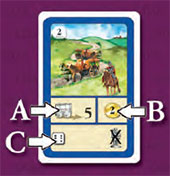
Your wagon represents the on-board location of your baggage train. The characteristics of your baggage train are detailed on your active (face up) Baggage Train Card:
- Your wagon's movement points.
- The gold you receive for delivering a commodity.
- The roll required to drive off a barbarian.
Example: Your active Baggage Train Card is shown below; so, you have 5 movement points for your wagon (A), you receive 2 gold when delivering a commodity (B), and you drive off a barbarian by rolling a "6" (C).
During trading and building on your turn, you may pay resources to upgrade to your next Baggage Train Card:
- Pay the resources shown on the top card of your Baggage Train stack.
- Turn the top card of that stack over and place it on top of your active Baggage Train Card. This card is now your active Baggage Train Card.
- Upgrading to the last Baggage Train Card in your stack is worth 1 victory point, as indicated on that card.
V. The Barbarians
Barbarians occupy paths. You may not build a road on a path occupied by a barbarian. Only 1 barbarian may occupy a given path.
A) Moving Past Barbarians
When moving your wagon along a path (road or no road) occupied by a barbarian, your movement point (MP) cost is 2 more than normally required (i.e., roadless-path + barbarian = 4 MPs; road-path + barbarian = 3 MPs).
If you do not have sufficient movement points to move past a barbarian, you either stop on the intersection before the barbarian and lose any unused MPs, or move in another direction.
B) Driving Off A Barbarian
If you upgrade your Baggage Train Card at least once, you can attempt to drive off a barbarian:
- Pause your moving wagon on an intersection adjacent to a barbarian.
- Roll one die.
- If the result is one of the die roll numbers shown on your active Baggage Train Card, you may move the barbarian to any path not already occupied by a barbarian.
- Regardless of whether you drive off the barbarian, you may continue moving your wagon normally using any remaining movement points. When you drive off a barbarian, you do not steal a Resource Card from another player.
- During each of your turns, you may only attempt to drive off a given barbarian once.
VI. A "7" is rolled
When you roll a "7" as your production roll, you must move one of the 3 barbarians to any path not already occupied by a barbarian. If you move a barbarian to a path occupied by a road, you may draw a Resource Card (not gold) from the owner of that road.
In addition, each player who has more than 7 Resource Cards must select half (rounded down) of his Resource Cards and return them to the bank.
VII. A "2" or a "12" is rolled
When you roll a "2" or a "12" as your production roll, re-roll the dice.
Viii. The Gold
The large gold coins are worth 5, while the small ones are worth 1.
Gold is important, it is used to pay for the movement along other players' roads. In addition, up to two times during your turn, you may buy a resource of your choice for 2 gold. You may also trade gold coins as if they were resources-you can trade with other players and with the bank at 4:1 (3:1 or 2:1 with harbors).
Gold does not count as a resource and is thus not considered when a "7" is rolled. Gold cannot be taken by using a "Monopoly" Development Card.
End of the Game
The game ends when a player has reached a total of 13 or more victory points during his or her turn.
Tips
Road building is very important, even though in this scenario no Special victory points are obtained for "Longest Road".
The more roads of your own, the faster you can move your wagon from one trade hex to another and the less gold you have to pay for the use of your fellow players' roads.
Always make sure that you have enough gold reserves. Otherwise you might find yourself sitting with your wagon between other players' roads and not being able to move on without gold.
Then, if none of your fellow players pays you gold for using your roads, your only option left would be to obtain gold from trading-with the other players, or using resources and the bank.
Continue Reading


